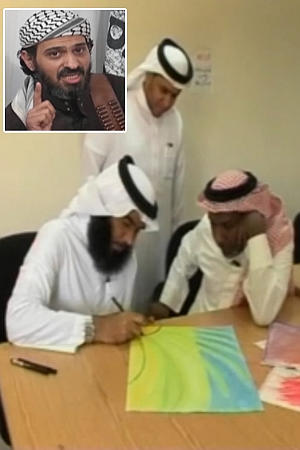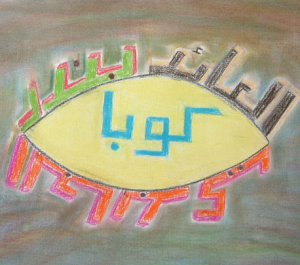Originally posted at American Thinker.
In November of 2007, one of four al-Qaeda leaders associated with the Northwest Airlines Flight 253 terrorist plot, Guantánamo prisoner #372 Said Ali al-Shihri was released from prison into the custody of Saudi government officials. In an endearing effort to reform militant jihadis, the Saudis enrolled the convicted terrorist in a psychological and religious program emphasizing art therapy.
Endeavoring to return potential terrorists to a “meaningful life,” a nation that would never even utter the word “art” established programs to provide “former detainees paints and crayons as part of a rehabilitation regimen.” In Arabic, the word art doesn’t “just mean painting or drawing, it also means dancing or singing and other stuff … not really well accepted.” So after completing official prison time, Islamic jihadists must spend two months participating in tashkeelym, which means creating with your hands.
Upon release from Gitmo, Said Ali al-Shihri willingly agreed to enter the Saudi “art therapy program,” where blending imagination and violence brings hope and change to radical terrorists. And why not? A creative arts program is a smooth transition from Gitmo-provided “lemon baked and orange glazed chicken,” and Sudoku puzzles and Red Cross-provided, top-shelf health care. By entering the program, al-Shihri continued to be a recipient of an established “soft approach to extremism” while receiving the additional enticement of a potential wife, as well as financial incentives of a home and a car (that he could choose to blow up in the future).
Encouraged by staff art therapist and “passionate advocate” Dr. Awad Alyami, the Saudi art therapy program gives convicted jihadis opportunities to express innermost compulsions for murder and mayhem with paint and crayons. Islamic law prohibits the reproduction of images depicting people or animals. Other than that, counterterrorism through creativity gives ex-Gitmo detainees like Said Ali al-Shihri the opportunity to be a terrorist-turned-art-student attending a “jihadi rehab,” where drawings of personally caused bloody carnage is out and sunshine and Quran verses are in.
In Yemen, where Umar Farouk got training and acquired explosives, a similar art-related remedy was discontinued because so many detainees promptly left the ceramics studio and returned to al-Qaeda’s battlefield.
Yet it was American officials who also agreed to send two terrorists, one of whom was Said Ali al-Shihri, from Gitmo to Saudi Arabia, where upon completion of program, both were set free. Then, by February 2009, the Saudi government released a list of 85 of the most wanted Saudi terrorists, which included eleven graduates of the art therapy program — one of whom was al-Shihri. Thirteen percent of Saudi Arabia’s most wanted terrorists were recidivist graduates of the peace through pastels program.
The bridge back to jihad is a short one if all it involves is two months of pretending to “get negative energy out on paper” while enjoying “tasty picnic-style meals of rice and lamb and snacks of Snickers” at a former desert resort. Out of curiosity, it would be nice to know whether America released Gitmo detainees to Saudi Arabia believing that art classes possess transformative powers to change terrorists into doves.
Visiting the Saudi facility, Canadian journalist Nancy Durham took note that “[i]f the inmates get it right here, they will soon be free, so they paint pictures as if their life depends upon it” — which is precisely the point. All ex-Gitmo prisoners had to do was to join “art therapy” classes in Saudi Arabia, and the doors of Gitmo swung open, whereupon enemy combatants were shuttled off to art class with boxes of Crayola crayons occupying backpacks in lieu of bombs. If the Saudis promise to expand the program to include ballet, butterfly collecting, and French cooking with soft-spoken Jacques Pepin, then Barack Obama may agree to empty the entire facility of remaining detainees before the end of next month.
Yet “[s]everal returnees from Guantanamo Bay continue to espouse a virulent hatred of the United States and Western society in general…that includes Shihri, who has been busy ignoring the peaceful precepts he was taught in terror rehab and has resumed his hardcore jihadist ways.” Former FBI agent and ABC News consultant Brad Garrett said that while the men claim to disavow radical militancy, “they basically schmooze or con their way out of the system, and then they get out.” After being freed, Ali al-Shihri rejoined the ranks of jihad and was promoted from finger-painting to the position of deputy leader of al-Qaeda in the Arabian Peninsula.
As Obama prepares to release 34 Gitmo detainees to active al-Qaeda base countries such as Yemen, psychological analysis needs to be done also on those who believe suicide bombers are incapable of pretending to demonstrate willingness to reconsider extremist views, if the end of the process means returning to the mujahideen brotherhood. For the likes of Ali al-Shihri, taking ceramics classes and participating in group hugs for sixty days was a small price to pay for the promise of killing American civilians on the other side of graduation day.
The long-term outcome of the “wacky jihad therapy” proves that jihadist rage is undeterred by well-meaning art programs. Apparently, al-Shihri’s revulsion for America was not exorcised through the “producing [of] dizzying Jackson Pollack rip-offs and imagining the aftermath of car bombings in crayon.” Paints and charcoal pencils aside, after leaving the program, Ali al-Shihri proved to be a successful jihadist mentor still able to encourage militant extremists to voluntarily tuck PETN in obscure body crevices in the hopes of committing suicide for the cause.
Disregarding Said Ali al-Shihri’s influence on Umar Farouk’s Christmas Day terrorist attempt, Barack Obama seems committed to closing Guantanamo Bay and releasing more enemy combatants. Someone with a grip on reality needs to advise the president that al-Qaeda fighters are mentally trained, if need be, to either finger-paint or be strapped to a bed of nails if the end result ensures an opportunity to get back to the business of training and equipping suicide bombers.


